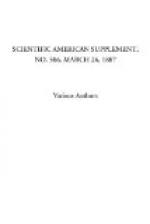* * * * *
Near Colorados, in the Argentine Republic, a large bed of superior coal has been opened, and to the west of the Province of Buenos Ayres extensive borax deposits have been discovered.
* * * * *
THE ANTI-FRICTION CONVEYER.
The accompanying engraving illustrates a remarkable invention. For ages, screw conveyers for corn and meal have been employed, and in spite of the power consumed and the rubbing of the material conveyed, they have remained, with little exception, unimproved and without a rival. Now we have a new conveyer, which, says The Engineer, in its simplicity excels anything brought out for many years, and, until it is seen at work, makes a heavier demand upon one’s credulity than is often made by new mechanical inventions. As will be seen from the engravings, the new conveyer consists simply of a spiral of round steel rod mounted upon a quickly revolving spindle by means of suitable clamps and arms. The spiral as made for England is of 5/8 in. steel rod, because English people would not be inclined to try what is really sufficient in most cases, namely, a mere wire. The working of this spiral as a conveyer is simply magical. A 6 in. spiral delivers 800 bushels per hour at 100 revolutions per minute, and more in proportion at higher speeds. A little 4 in. spiral delivers 200 bushels per hour at 100 revolutions per minute. It seems to act as a mere persuader. The spiral moves a small quantity, and sets the whole contents of the trough in motion. In fact, it embodies the great essentials of success, namely, simplicity, great capacity for work, and cheapness. It is the invention of Mr. J. Little, and is made by the Anti-friction Conveyer Company, of 59 Mark Lane, London.
[Illustration: THE ANTI-FRICTION CONVEYER WITH CASING OR TROUGH—END VIEW WITH HANGER.]
Since the days of Archimedes, who is credited with being the inventor of the screw, there has not been any improvement in the principle of the worm conveyer. There have been several patents taken out for improved methods of manufacturing the old-fashioned continuous and paddle-blade worms, but Mr. Little’s patent is the first for an entirely new kind of conveyer.
* * * * *
STUDIES IN PYROTECHNY.
[Footnote: Continued from SUPPLEMENT, No. 583, page 9303.]
II. METHODS OF ILLUMINATION.
Torches consist of a bundle of loosely twisted threads which has been immersed in a mixture formed of two parts, by weight, of beeswax, eight of resin, and one of tallow. In warm, dry weather, these torches when lighted last for two hours when at rest, and for an hour and a quarter on a march. A good light is obtained by spacing them 20 or 30 yards apart.
Another style of torch consists of a cardboard cylinder fitted with a composition consisting of 100 parts of saltpeter, 60 of sulphur, 8 of priming powder, and 30 of pulverized glass, the whole sifted and well mixed. This torch, which burns for a quarter of an hour, illuminates a space within a radius of 180 or 200 yards very well.




